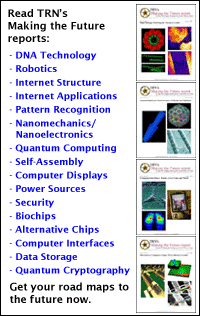
Fingernails
store data
By
Kimberly Patch,
Technology Research NewsIt's the stuff of spy fiction.
Researchers from the University of Tokushima and Hokkaido University have demonstrated that it is possible to read data written into a human fingernail using a laser, much like information is written on a rewritable compact disc. The data is read using an optical microscope.
The researchers' original idea was to find a way to write data directly to some part of the human body for security purposes. They considered hair, teeth and skin before settling on fingernails.
The researchers' proof-of-concept demonstration involved recording and reading numbers, Japanese characters, and an English word in dot patterns on the inside of a human fingernail.
The method could be used for personal authentication, said Yoshio Hayasaki, an associate professor of optical science and technology at the University of Tokushima. It could also be used in conjunction with biometric authentication like fingerprints and vein patterns, he said.
The researchers tried several technologies before finding a method of writing data into fingernails so that it can be easily read, said Hayasaki.
They wrote dot patterns into a fingernail using a laser that emitted pulses lasting a few million billionths of a second. The molecules of the fingernail that were hit by the laser became ionized, and because ionized molecules repulse each other, they caused a tiny explosion. The explosion changed the structure of the material at that location by decomposing the keratin protein molecules located there. These areas can be read because they fluoresce, or absorb and emit light, at a higher rate than the surrounding fingernail material.
The tiny explosion areas are about three microns wide and 20 microns deep, and can be written five microns apart. The researchers recorded and read three layers of these dots, at 40, 60 and 80 microns below the nail surface. The dots are visible under blue light, and thus can be read using a microscope. A micron is one thousandth of a millimeter.
Two gigabits of data can be written per cubic centimeter of fingernail using these size dots. Today's compact discs hold about 5.6 gigabits of data. A practical fingernail recording area of 5 millimeters by 5 millimeters by one tenth of a millimeter deep would hold 5 megabits of data, or about 300 pages of text.
The researchers' proof-of-concept samples could still be read 172 days after recording. This is probably the practical limit of fingernail storage because after six months a fingernail has grown enough to be completely replaced.
The researchers' next step in making the method practical is to find a safe, inexpensive way to write data. "The important things for practical use are to ensure safety and reduce costs," said Hayasaki. "We need [a] more sophisticated laser processing system to write data in the nail on a finger, because the finger moves," he said.
The researchers are in the process of developing a femtosecond laser writing system that can compensate for movement as it is recording data, said Hayasaki.
The method could be practical within three years, said Hayasaki.
Hayasaki's research colleagues were Akihiro Takita, Hirotsugu Yamamoto and Nobuo Nishida at the University of Tokushima, and Hiroaki Misawa at Hokkaido University. The work appeared in the June 13, 2005 issue of Optics Express. The research was funded by the University of Tokushima, the Mazda Foundation, the Secom Science and Technology Foundation, the Telecommunications Advancement Organization of Japan, and the Japanese Ministry of Education, Science, Sports and Culture.
Timeline: 3 years
Funding: Corporate, Government
TRN Categories: Data Storage Technology; Optical Computing, Optoelectronics and Photonics
Story Type: News
Related Elements: Technical paper, "Three-dimensional Optical Memory Using a Human Fingernail," Optics Express, June 13, 2005
Advertisements:
July 27/August 3, 2005
Page One
Stories:
Traffic model maps congestion
Fingernails store data
Quantum crypto scheme doubly fast
How It Works: Internet Structure
Briefs:
Baited molecule fights cancer
Bacteria drive biochip sensor
System brightens dark video
Micro fuel cell packs power

News:
Research News Roundup
Research Watch blog
Features:
View from the High Ground Q&A
How It Works
RSS Feeds:
News
Ad links:
Buy an ad link
| Advertisements:
|
 |
Ad links: Clear History
Buy an ad link
|
TRN
Newswire and Headline Feeds for Web sites
|
© Copyright Technology Research News, LLC 2000-2006. All rights reserved.